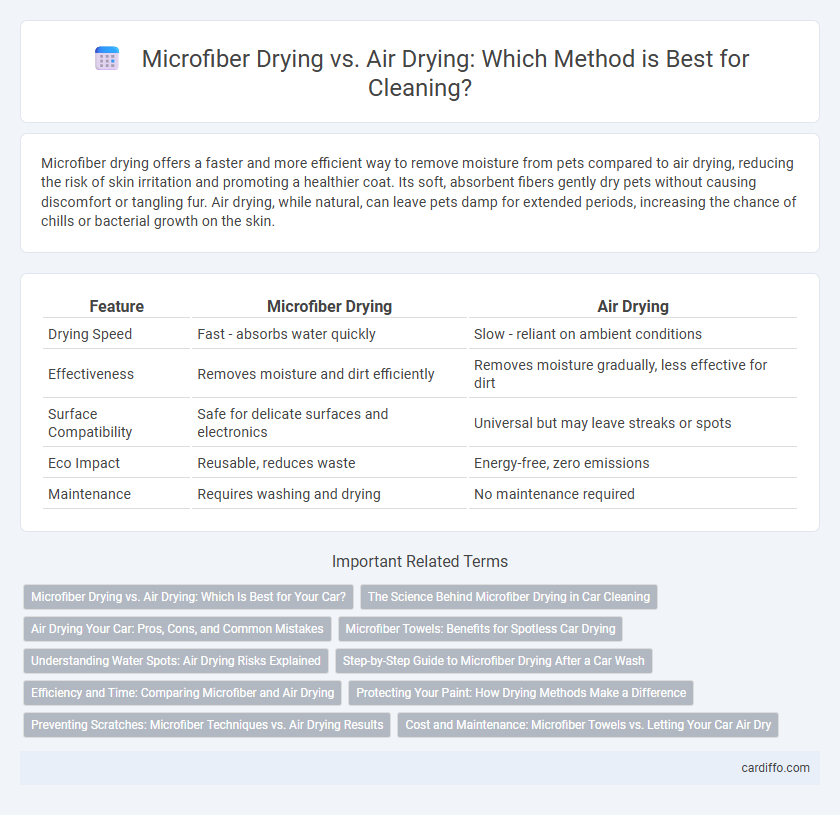Microfiber drying offers a faster and more efficient way to remove moisture from pets compared to air drying, reducing the risk of skin irritation and promoting a healthier coat. Its soft, absorbent fibers gently dry pets without causing discomfort or tangling fur. Air drying, while natural, can leave pets damp for extended periods, increasing the chance of chills or bacterial growth on the skin.
Table of Comparison
| Feature | Microfiber Drying | Air Drying |
|---|---|---|
| Drying Speed | Fast - absorbs water quickly | Slow - reliant on ambient conditions |
| Effectiveness | Removes moisture and dirt efficiently | Removes moisture gradually, less effective for dirt |
| Surface Compatibility | Safe for delicate surfaces and electronics | Universal but may leave streaks or spots |
| Eco Impact | Reusable, reduces waste | Energy-free, zero emissions |
| Maintenance | Requires washing and drying | No maintenance required |
Microfiber Drying vs. Air Drying: Which Is Best for Your Car?
Microfiber drying offers superior absorbency and reduces water spots by quickly wicking moisture from your car's surface, while air drying often leads to mineral deposits and streaking. The ultra-soft fibers of microfiber towels prevent scratches and swirl marks, preserving your car's paint integrity compared to the potential contaminants left by air drying. Choosing microfiber drying ensures a faster, safer, and more effective method to maintain your vehicle's showroom shine.
The Science Behind Microfiber Drying in Car Cleaning
Microfiber drying cloths leverage high absorbency and fine fibers to efficiently trap and lift water from car surfaces, minimizing water spots and streaks commonly left by air drying. The densely woven synthetic fibers create capillary action that accelerates moisture removal while being gentle on paint finishes, reducing the risk of scratches and swirl marks. Compared to air drying, microfiber drying significantly shortens drying time and enhances overall finish quality by preventing prolonged water residue.
Air Drying Your Car: Pros, Cons, and Common Mistakes
Air drying your car saves time and reduces the risk of streaks or lint left by towels, but it often results in water spots caused by mineral deposits as water evaporates. Common mistakes include leaving water droplets on the surface too long and not choosing shaded areas, which increases the chances of spotting and oxidation. To minimize drawbacks, use filtered water for washing and park in a shaded, well-ventilated spot to speed drying while protecting the paint.
Microfiber Towels: Benefits for Spotless Car Drying
Microfiber towels offer superior absorbency and quick drying capabilities, making them ideal for achieving a spotless car finish without streaks or water spots. Their fine fibers effectively lift and trap dust, dirt, and moisture, reducing the risk of surface scratches compared to traditional drying methods. Using microfiber towels ensures a cleaner, more polished look while protecting automotive paintwork during the drying process.
Understanding Water Spots: Air Drying Risks Explained
Microfiber drying effectively absorbs moisture, reducing the risk of water spots by minimizing leftover droplets on surfaces. Air drying leaves water exposed to minerals and contaminants that can settle, causing visible spots and streaks on glass, metal, and painted finishes. Understanding the chemical composition of tap water and environmental factors helps explain why air drying often results in unsightly water spots compared to microfiber cloths.
Step-by-Step Guide to Microfiber Drying After a Car Wash
After washing a car, use a high-quality microfiber drying towel to gently blot and absorb water from the surface, starting from the roof and working downward to prevent water spots. Employ a soft, circular motion to lift water without scratching the paint, targeting areas around mirrors, door handles, and crevices for thorough drying. Ensure the microfiber towel is clean and dry, folding it regularly to expose a fresh surface, maximizing water absorption and protecting the car's finish.
Efficiency and Time: Comparing Microfiber and Air Drying
Microfiber drying significantly reduces drying time due to its high absorbency and quick moisture-wicking properties, making it more efficient than air drying, which can take several hours depending on environmental conditions. The dense fibers of microfiber towels enhance evaporation by maximizing surface area contact, enabling faster drying of surfaces and fabrics. Air drying is energy-efficient but less time-effective, often resulting in prolonged dampness that may encourage bacterial growth.
Protecting Your Paint: How Drying Methods Make a Difference
Microfiber drying protects your paint by using ultra-fine fibers that gently absorb water without causing scratches or swirl marks. Air drying leaves water spots and mineral deposits on the paint surface, which can lead to etching and long-term damage. Choosing microfiber towels aids in preserving the paint's glossy finish and extends the life of protective coatings.
Preventing Scratches: Microfiber Techniques vs. Air Drying Results
Microfiber drying significantly reduces the risk of scratches by gently lifting and trapping dirt particles away from surfaces, preventing abrasive contact. Air drying often leaves mineral deposits and trapped dust on surfaces, increasing the chance of micro-scratches during evaporation. Employing microfiber cloths ensures a smoother, scratch-free finish compared to the natural drying process.
Cost and Maintenance: Microfiber Towels vs. Letting Your Car Air Dry
Microfiber towels reduce drying time and minimize water spots, cutting long-term maintenance costs compared to air drying, which can require repeated washes to remove dust and dirt accumulation. Although microfiber towels have an initial cost, their durability and reusability lower overall expenses by preventing surface damage during drying. Air drying costs nothing upfront but raises the risk of contaminants causing paint imperfections, potentially increasing future detailing or repair expenses.
Microfiber drying vs Air drying Infographic

 cardiffo.com
cardiffo.com